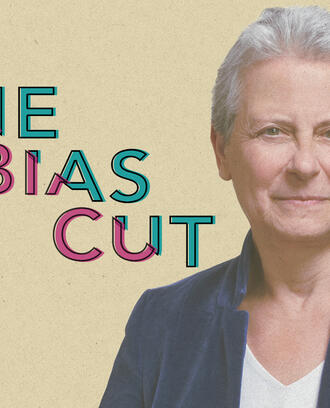Credit: Caitlin Cunningham
Ideas Made to Matter
Leadership
Why Pixar founder Ed Catmull wants you to ‘fail the elevator test’
By
Ed Catmull has a computer science PhD, introduced computer graphics technology to Lucasfilm, cofounded Pixar Animation Studios, worked side by side with Steve Jobs, and spearheaded the creative team behind animated blockbusters like "Toy Story" and "Ratatouille."
None of which suggests he is much familiar with failure. Yet speaking as part of MIT Sloan’s Innovative Leadership Series, Catmull said failure, uncertainty, and overreaching are essential ingredients to creative growth.
Take the legendary “elevator test” — the ability to pitch an idea to higher ups in the time it takes to ascend to the executive suite. “If you can pass that test, [your idea] is probably derivative of what’s been done before,” Catmull said.
Ambitious, unlikely ideas — “a rat that wants to cook, or an old man who floats away on a balloon with a stowaway,” Catmull said — can’t be summed up in 30 seconds, but they can go on to become the Oscar-winning Pixar films “Ratatouille” and “Up,” respectively.
Here are other observations from Catmull’s career spent straddling the gap between technology and art:
Don’t be afraid to say “I don’t know”
From his first job on, Catmull never felt quite ready for the next role or challenge, but he didn’t let any doubt or perceived deficit get in the way. “When I got to New York Tech I was in over my head. When I got to Lucasfilm I was in over my head, and when we started Pixar, I was really in over my head,” he recalled.
When he first arrived at Lucasfilm, Catmull had no minted strategy to transition the studio to computer graphics and digital video editing technologies, and a similar scenario ensued at Pixar.
“Steve Jobs acquired us to start Pixar, and we entered into a contract with Disney for the coloring of cells for 2D animated films,” he recounted. “We had some theories how to do things, but fundamentally I didn't know what I was doing. I was absolutely in over my head.”
At each juncture, Catmull was completely transparent about what he didn’t know. “I looked at being in over my head as a feature, not a bug,” he said. “I don’t have anything to hide. I can admit to people that I don’t know, and in doing so, we can engage in discussion and talk about problems.”
It’s all part of his management style to surface issues, not bury them. As Catmull wrote in his 2014 book, "What makes Pixar special is that we acknowledge that we will always have problems, many of them hidden from our view, that we work hard to uncover these problems even if doing so means making ourselves uncomfortable, and that when we come across a problem we marshal all of our energies to solve it.”
Conflict can be cathartic
Creating award-winning animated films demands both artistic and technological talent. As a high-profile chief executive, Catmull was constantly at the epicenter of managing the needs of two seemingly distinct groups.
On top of that, the team encompassed some of the biggest names in the entertainment and tech industries — from the veteran crew that started Pixar on up to Jobs himself.
Over the years, Catmull devised a number of strategies to leverage conflict to his team’s creative advantage. Early on, he identified a perceived class distinction between creative and technical talent — at Disney, creatives reigned; at Microsoft, which was working with Disney to put animated content on CDs, techies were dominant.
Catmull worked hard to knock those barriers down. His management team made it a priority to debunk stereotypes such as the longstanding one that creative people are difficult to work with. “I’ve got world-class people in technology and art, and their ability to organize and to think are roughly the same,” he said. “There are technical people who are disorganized and dysfunctional and argumentative, and there are artists who are crystal clear in their thinking and make great creative leaders.”
As a manager, Catmull said, he tolerated a fairly high degree of disagreement between team mates, as long as the conflict didn’t turn personal. “We can have people who can argue such that they turn red in the face, but it’s about the problem,” he says. “As long as it’s focused on the problem then we get the best possible outcome.”
“In solving difficult problems, you’re doing something original and creative,” Catmull said. “You’re giving something to the world, but you’re also sending an internal message about who you are as an organization.”
Failure is (sometimes) part of the process
To achieve something original, you must start with something unlikely, and that increases risk, Catmull said. At Lucasfilm, his benchmark was to have a third of creative efforts be successful, a philosophy that carried over to Pixar, where a film idea might go through eight or nine creative rounds with roughly three months in between to massage the concept — or in some cases, scrap it all together, he said.
“New ideas that are thrown out at the beginning frequently fail, but because we expect it and everyone’s been through it, they aren’t thought of as failures,” Catmull said. “Sometimes you don’t find the emotional core until the end, which makes it scary. That’s what happened in ‘Up,’” he recalled. “Sometimes you find the emotional core at the beginning, which is what happened with ‘Toy Story 3.’
Key to the process is creating a culture and safe environment that encourages experimentation and feedback and doesn’t punish failure. “When we have feedback sessions, we have to acknowledge the vulnerability of the people who are presenting and do everything we can to make it safe for them to be vulnerable,” he said. “That’s a conscious effort, and I think we’ve been very successful at it.”
Catmull is often asked, and often declines, to name a favorite among the many Pixar films he has worked on. “I’m going to have to stick to the cheap answer, which is, I can't say. The films mean something different to me than they do to others. I see the difficulties, the things that don’t work, the personnel problems, the clashes,” Catmull said. “It’s like having children and saying who’s your favorite.”



